Changes to Steerage Conditions on Steamships - 1912
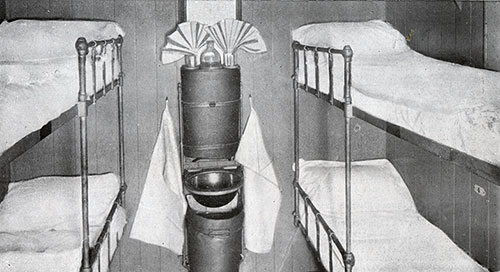
Third Class / Steerage Four-Berth Room. 1912 Brochure RMS Franconia and Laconia - Cunard Line. GGA Image ID # 118805de77
Change to Steamships.
Steamships, as soon as introduced, afforded better steerage conditions than sailing vessels; but it always takes time for the new to displace the old. Steamers crossed the ocean and carried passengers early in the forties, but previous to 1850 they played no important part in the transportation of steerage passengers to America.
The swifter and better ships were first put at the service of men able to pay; the real immigrants down to the later sixties continued to come in large numbers in sailing vessels and had to risk a death rate at sea which was appalling.
It was only a question of time, however, when the passenger traffic of all classes would pass over to the better equipped and swifter vessels.
In the year 1856, only 3 percent of the passengers landing in Castle Garden were carried in steamships; ten years later the percentage was 67.9, and in another decade the sailing vessel as a conveyor of immigrants was practically abandoned. The better way had prevailed, and steerage accommodations were significantly improved.
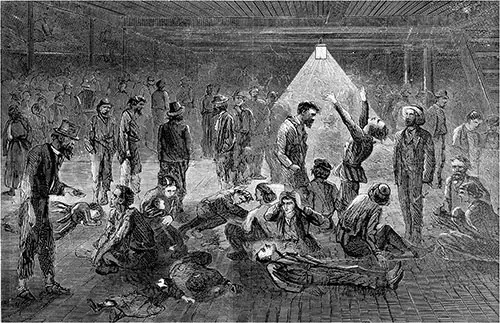
Horrors of the Emigrant Ship -- Scene in the Hold of the "James Foster, Jr." - 1869. Harper's Weekly, 27 March 1869. GGA Image ID # 145fe7f646
No longer were hunger and thirst a menace; fevers and epidemics were not banished from transporting vessels, but the voyage was reduced to a few days, and the terrible death rate at sea was virtually obliterated. The invention had made it possible for the real emigrants to cross the ocean in safety.
See Immigration Commission, Abstract of Report " Steerage Legislation,"
INDUCEMENTS TO EMIGRATE
Thousands of cabin passengers cross the ocean for pleasure; the steerage passengers, almost to a man, seek a better country. The steamship companies study the comfort and convenience of the pleasure seeker, but the necessities of the true emigrant have had the least possible attention.
Steerage conditions have often been denounced as a disgrace to civilization and remedies have only been affected by the lash of legal enactment.
Emigrants who came to America in sailing vessels previous to the sixties of the last century can never forget the steerage conditions from which they came.
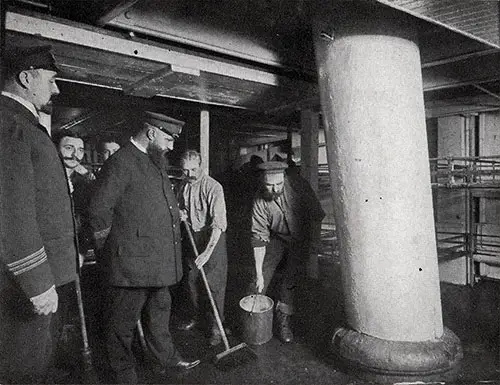
Cleaning Up In the Steerage. The World's Work, April 1901. GGA Image ID # 146bcd678a
The dread of hunger and thirst, the terrible ravages of ship fever and epidemics, the absence of conveniences which common decency demands, —these ordeals still hang like a pall in their memories, and more than half a century of life in the United States has not been able to obliterate the impression.
The throes of that voyage — made two generations ago — are still rehearsed with a feeling which can only be explained by the abject misery endured.
Steerage Conditions.
Steerage conditions in modem steamships are not ideal, but they are steadily improving. A comparison of the accommodations furnished at present by the better class of vessels with those found on all steamships in the early eighties of the last century is the best argument of the progress made.
In the early 1880s, every steamship had compartments for steerage passengers, in which hundreds of men were huddled together in berths which afforded bare room to lie down.
The berths were two deep, and each passenger paid a small sum for a mattress of straw made to fit the berth; he also provided himself with platter and cup, knife and fork, and spoon, which he had to keep clean and stow away for safe keeping.
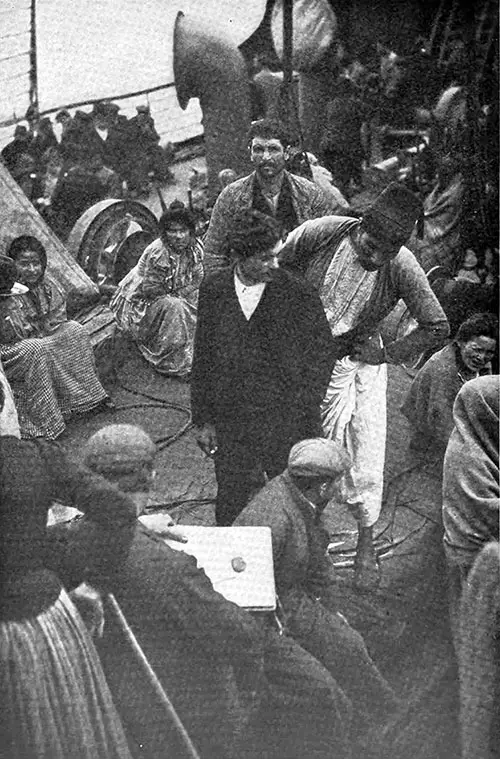
Passengers in Steerage Included Greeks and Syrians, Croatians, Spaniards, Italians and Jews. Photo by N. Lazarnick. Leslie's Monthly Magazine, May 1904. GGA Image ID # 1460f3e598
There was no room provided to place hand baggage or small trunks save in the berth. When the man got in, the baggage got out, so that during sleeping hours the small baggage occupied the pathway leading to the berths; if the vessel rocked hard during the night, the rattle of tins and crockery was great, and, in the morning, it was no easy task to locate the grip or small trunk that had slid away.
Towels and soap, comb and brush, were nowhere in sight, and the washroom and toilet accommodations were far from decent. The air in the compartment was foul at all times, and every passenger spent as little time there as possible.
None of the immigrants thought of undressing when they went to rest — they took off their shoes, removed their coats, and turned in, and with the dawn, they were again on deck.
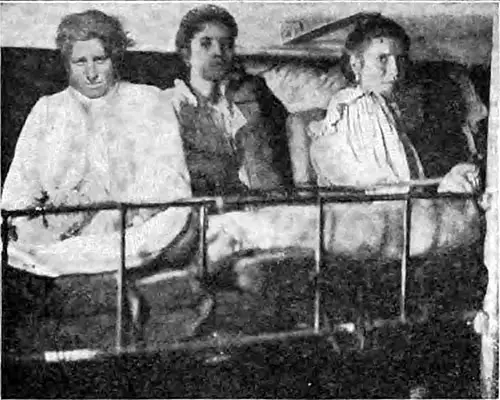
Upper Bunks in the Women's Compartment Showing the Life-Preserver Pillows. Leslie's Monthly Magazine, May 1904. GGA Image ID # 1461ac12d2
No dining room was provided, but the space between the two rows of berths served as one. Some smooth boards, resting on wooden horses, served as a table. In front of the tables were benches.
When the meal bell rang, a rush was made for these; then the stewards brought bread, meat, vegetables, etc., each passenger in turn being served as the waiters passed from one end of the table to the other.
The bread was good; the meat, tough; the coffee, poor; and the tea — slop. All passengers counted the days as they plowed the deep, and the one consoling thought was, "It won't last long."
Blessed were those who had provided some fruit and supplemental articles of diet; some passengers found their way to the cook's quarters and secured dainties at a price; others patronized the canteen and found cheer in strong' drink.
Improved Conditions
Compared with these steerage conditions, the new type is much better, mainly that denominated "third class." In this are found inclosed berths to accommodate from four to eight persons.
Room is provided for small trunks or hand baggage, and there are hooks upon which to hang clothes. A stationary washstand with towels is furnished, and the button of an electric alarm is near each berth, so that the occupant may, in case of need, summon a steward.
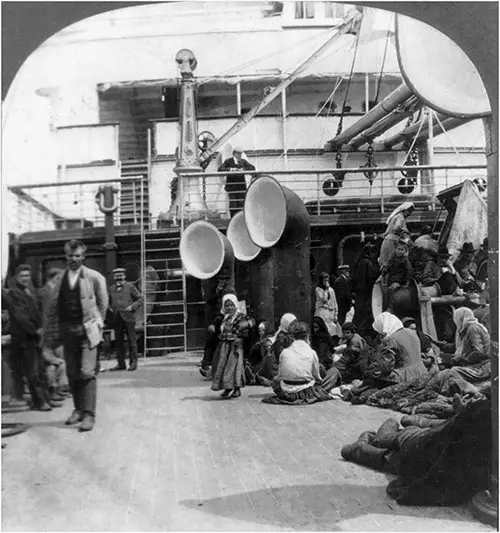
Steerage Passengers Taking Life Easy on an Ocean Liner circa 1905. Immigrants. Open deck with bridge in background 3 funnels in center, immigrants walking and seated at sides of image. Library of Congress # 2005693063. GGA Image ID # 145ef67d24
The occupants of these quarters secure a degree of privacy that enables them to remove their clothes before they retire. The lavatories are decent, and the conveniences provided are ample and always usable.
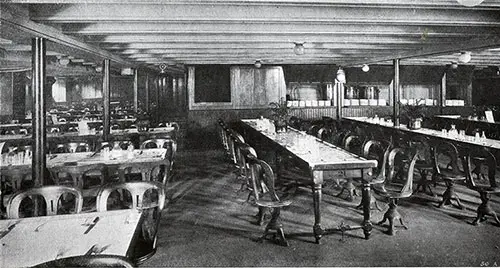
Third Class / Steerage Dining Room. 1912 Brochure RMS Franconia and Laconia - Cunard Line. GGA Image ID # 11885a4643
Regular dining rooms are provided, and the utensils used are furnished by the company and kept clean by the stewards. The food is ample and of good quality, providing care has been exercised in its preparation.
These improvements are not common as yet they are only found on some ships carrying steerage passengers from the northwestern countries of Europe, but they are a promise and a prophecy of what will in time be installed in all steamships carrying immigrants to the United States.
The ideal as presented by advocates of improved steerage conditions is not yet reached, but a higher standard as to space, facilities, ventilation, and food obtains today than ever before, and the tendency is in the right direction.
The steerage conditions ought to be to each immigrant suggestive of the standard of domestic, social, and moral life in the country to which he comes.
Roberts, Peter, Ph.D., The New Immigration: A Study of the Industrial and Social Life of Southeastern Europeans in America, New York: MacMillan Company, 1912.
